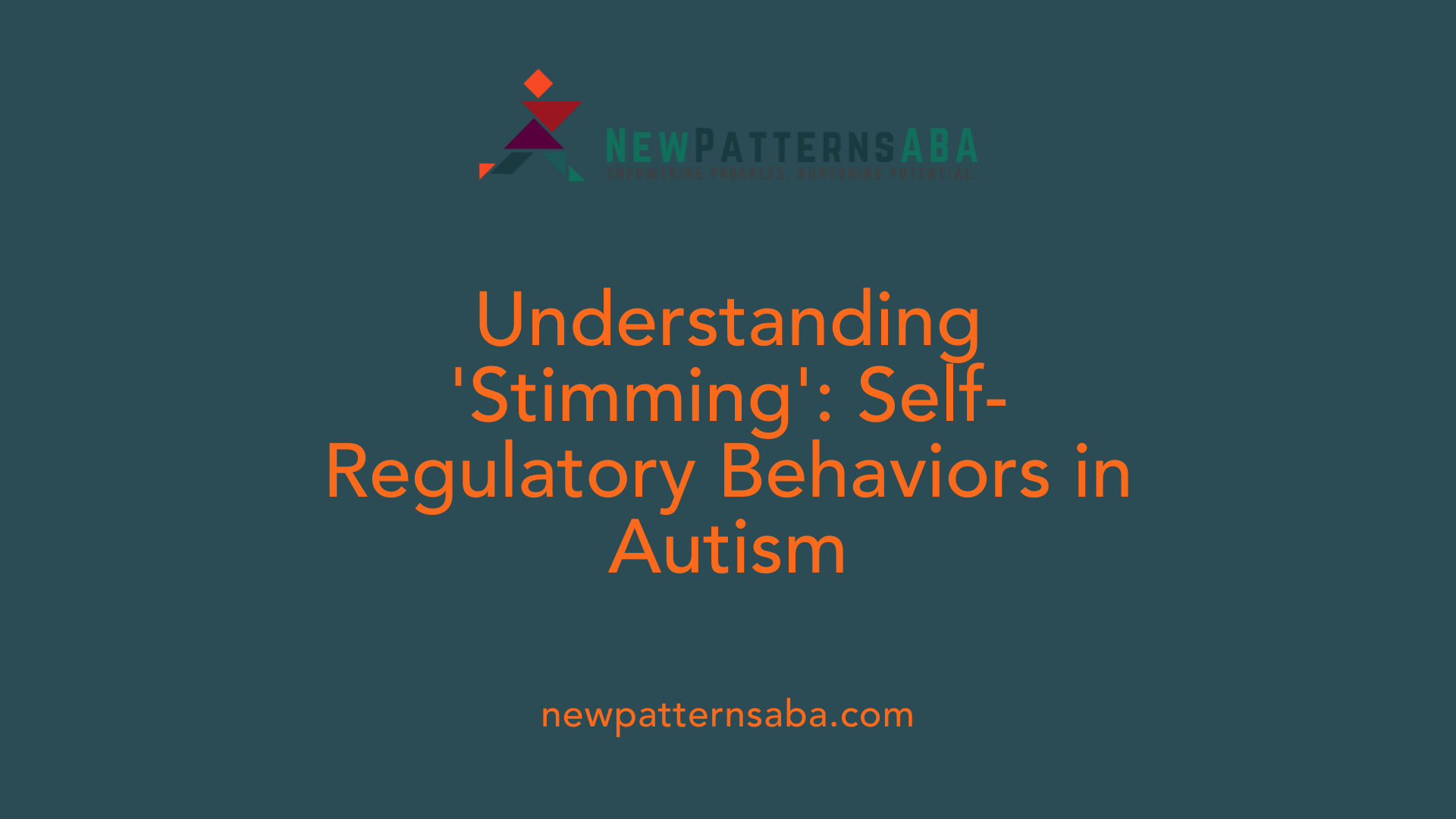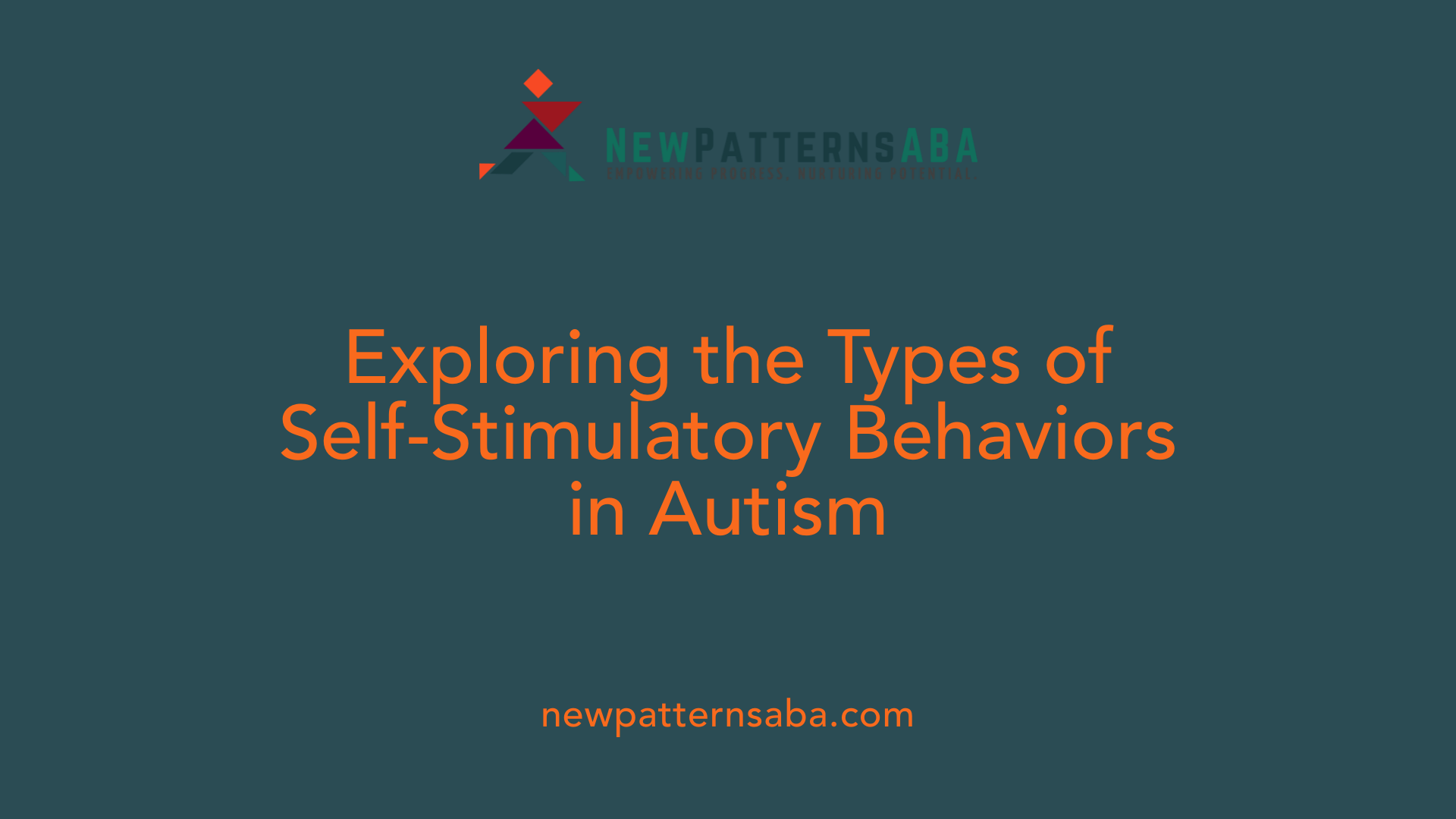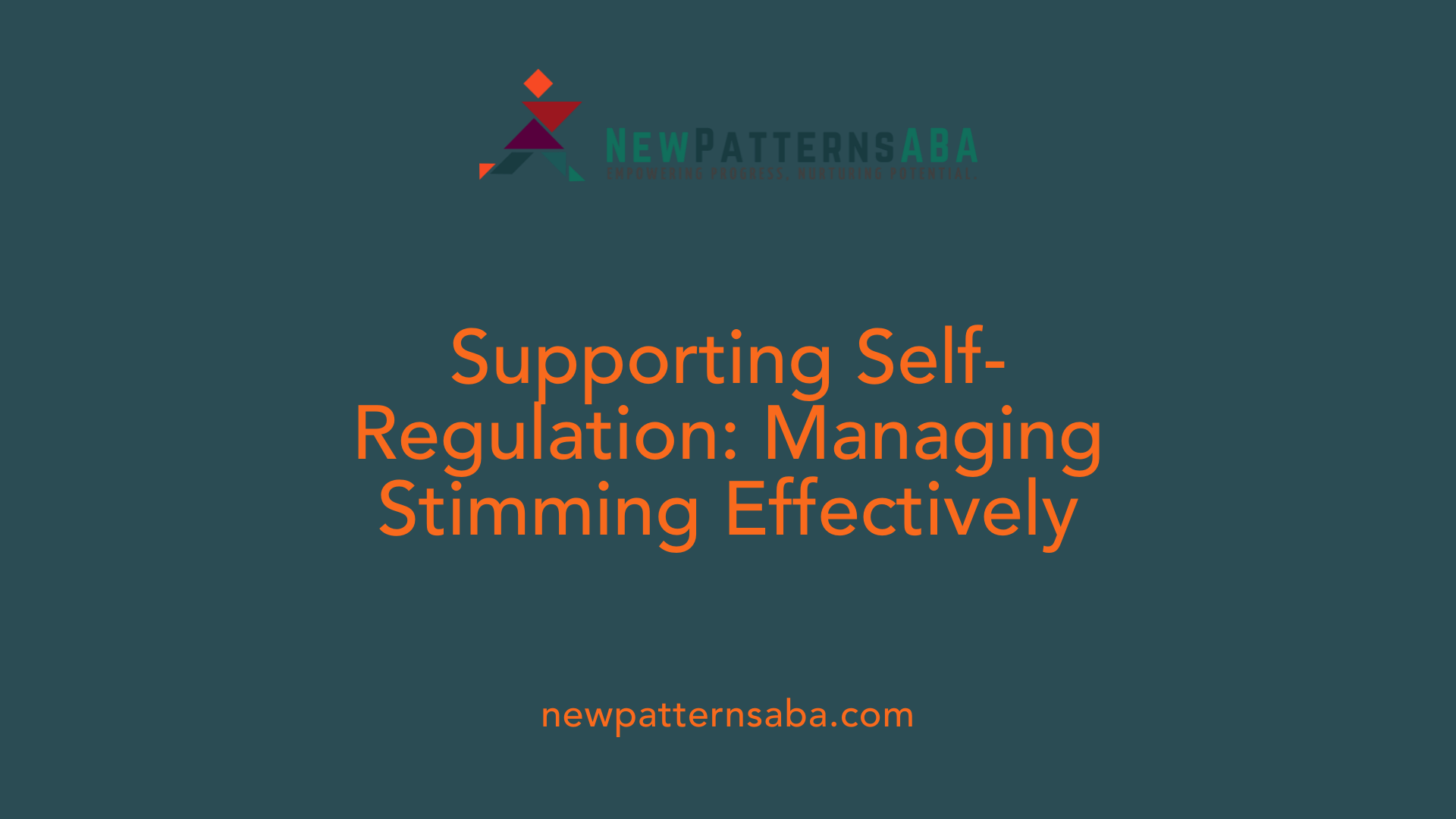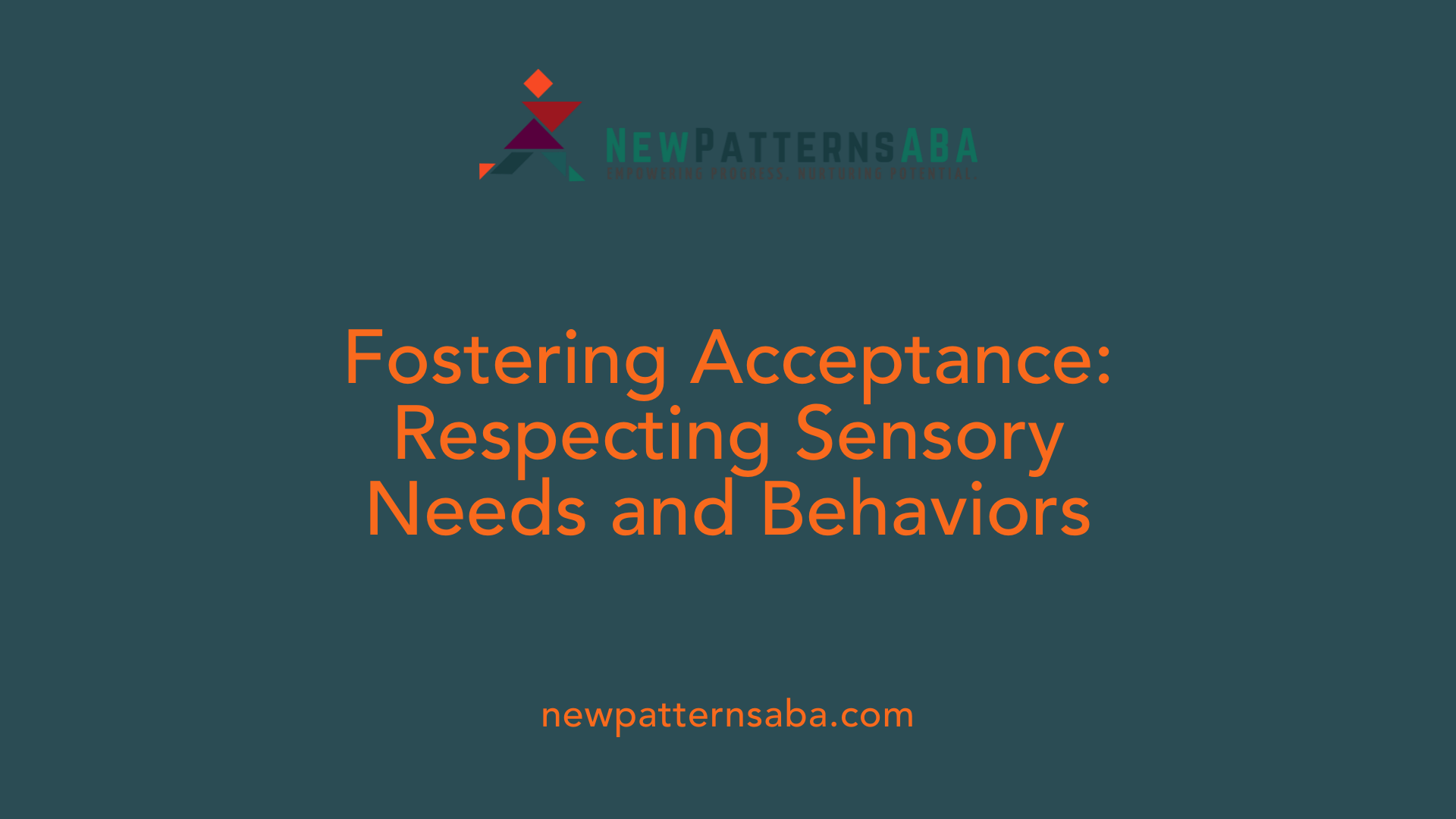Understanding and Supporting Sensory Needs in Autism
An Introduction to Self-Stimulatory Behaviors
Self-stimulatory behaviors, often called stimming, are common and natural actions performed by individuals with autism to self-regulate, express emotions, or manage sensory input. Recognizing these behaviors is essential for providing support that enhances their well-being and social integration.
What Are Self-Stimulatory Behaviors in Autism?

What are self-stimulatory behaviors in autism?
Self-stimulatory behaviors, often called 'stimming', are repetitive actions or movements that individuals with autism use for self-regulation. These actions help them manage emotions, cope with sensory input, and sometimes communicate unspoken needs.
Stimming includes a wide range of activities such as rocking, pacing, hand-flapping, spinning objects, lining up toys, or making vocal noises. These behaviors serve important functions, often providing sensory pleasure, reducing anxiety, or helping to focus attention.
While stimming can be harmless and even beneficial, it may sometimes interfere with daily activities, social interactions, or learning. Certain behaviors like head-banging are more disruptive and require careful management.
Most people, regardless of neurodiversity, engage in some form of self-stimulatory activity during moments of excitement, nervousness, boredom, or fear. For example, tapping a pen or whistling are common and usually go unnoticed.
Supporting individuals with autism involves understanding the purpose of their stimming behaviors, which often relate to emotional or sensory needs.
Functions of self-stimulatory behaviors
Self-stimulatory behaviors serve multiple functions, including:
- Sensory regulation: helping manage sensory overload or seeking sensory stimulation.
- Emotional regulation: calming nerves or reducing anxiety.
- Attention and focus: aiding concentration on tasks.
- Communication: expressing needs or discomfort.
- Self-comfort: providing a sense of safety and familiarity.
Recognizing these functions is crucial for developing effective support and management strategies.
Common examples of stimming
Here is a list of typical stimming behaviors:
| Behavior | Description | Possible Function |
|---|---|---|
| Rocking | Repetitive back-and-forth or side-to-side movement | Sensory regulation, calming |
| Hand-flapping | Flapping or waving hands repeatedly | Emotional regulation, excitement |
| Spinning objects | Rotating toys or objects continuously | Sensory seeking |
| Aligning objects | Lining up or arranging objects meticulously | Visual stimulation, focus |
| Vocalizations | Repeating sounds or phrases | Communication, self-expression |
| Pacing | Walking back and forth | Anxiety reduction, physical activity |
While some forms of stimming are harmless, understanding their purpose allows caregivers, educators, and therapists to support the individual better.
Managing stimming behaviors involves identifying triggers, teaching suitable alternative behaviors, and providing a supportive environment. For example, instead of hand-flapping, a person might be instructed to tap their fingers on a table or put their hands in their pockets.
How to address and support stimming behaviors
It’s important to approach stimming with patience and understanding. Simply stopping the behavior without understanding its purpose may lead to increased frustration or more disruptive habits.
Instead, a common strategy involves:
- Identifying triggers for the behaviors.
- Teaching alternative, appropriate actions that satisfy the same sensory or emotional need.
- Limiting attention to redirections to avoid reinforcing the behavior.
In some cases, particularly during stressful situations, behaviors might re-emerge. These instances can sometimes be managed through calming techniques, introducing new alternatives, or, with medical consultation, medication.
Supporting safe and acceptable stimming helps guardians, teachers, and therapists to improve the individual’s overall quality of life. It enables better learning, more comfortable social interactions, and a more fulfilling daily experience.
Supporting intervention approaches
Applied Behavior Analysis (ABA) therapy is commonly used to understand and manage stimming. Rather than aiming to eliminate these behaviors outright, ABA focuses on understanding their underlying triggers and functions.
Interventions include:
- Functional assessments to identify the causes of stimming.
- Teaching communication, social, and self-regulation skills as alternatives.
- Respecting individual differences and balancing support with personal preferences.
- Supporting families with patience, education, and empathy.
The ultimate goal is to naturally reduce problematic behaviors as individuals develop more adaptive skills, ensuring they can express themselves and meet their sensory or emotional needs in appropriate ways.
Types of Self-Stimulatory Behaviors and Their Sensory Engagement

What are the different types of self-stimulatory behaviors in autism?
Self-stimulatory behaviors, or 'stimming', are repetitive actions that individuals with autism often engage in to help regulate their sensory experiences and emotions. These behaviors can include a wide array of movements, sounds, and physical activities. The types of stimming are diverse and serve various functions, often tailored to meet an individual's specific sensory and emotional needs.
Many of these behaviors are categorized based on the sensory modality they involve. Understanding these categories helps caregivers and therapists develop supportive strategies that respect individual differences.
Categories of stimming based on sensory modality
| Sensory Modality | Examples of Stimming Behaviors | Functions or Purposes | Additional Notes |
|---|---|---|---|
| Auditory | humming, listening to repetitive sounds | Self-soothing, focus, calming | Can include repeating phrases or sounds |
| Oral & Olfactory | biting objects, smelling familiar scents | Comfort, sensory regulation | Often seen as a way to explore smell or taste |
| Tactile | rubbing surfaces, touching textures | Comfort, sensory input regulation | Involves physical contact with textures |
| Vestibular & Proprioceptive | rocking, spinning, jumping | Movement regulation, calming, alertness | Large movements involving balance and spatial awareness |
| Visual | staring at lights or visual patterns | Focus, sensory stimulation | Visual stimming can be soothing or stimulating |
| Vocal | repeating words, sounds or phrases | Communication, anxiety reduction | Vocalizations can be involuntary or intentional |
Examples of different types of stims
- Body rocking or bouncing (vestibular): Moving the body rhythmically back and forth.
- Hand flapping or finger flicking (tactile): Repetitive hand movements that serve to comfort or focus.
- Spinning objects or oneself (vestibular): Activities that provide visual and balance stimulation.
- Repeating sounds or phrases (vocal): Often used to self-regulate or mitigate anxiety.
- Biting or chewing objects (oral): To manage oral sensory input or provide oral stimulation.
- Fixating on lights or patterns (visual): Gaze at flickering lights or visual patterns for sensory engagement.
Functions served by various types of stimming
Stimming behaviors serve vital biological and emotional functions for individuals with autism. Some of the primary functions include:
- Sensory regulation: Helping to modulate sensory input, especially when overwhelmed.
- Emotional regulation: Soothing anxiety, frustration, or excitement.
- Attention and focus: Improving concentration or blocking out distracting stimuli.
- Communication: Expressing feelings or needs when verbal communication is limited.
- Self-comfort: Providing a sense of safety and stability during stressful situations.
Understanding these functions and the types of behaviors is crucial for designing effective support strategies. It allows caregivers and therapists to teach appropriate, safe alternatives that fulfill the same functions without disrupting daily life.
Supporting Individuals with Autism in Managing Stimming
While many stims are harmless and serve positive functions, some behaviors can interfere with daily activities or pose safety concerns. A compassionate approach involves identifying triggers, understanding the purpose of the behaviors, and teaching suitable alternatives. For example, instead of hand flapping when anxious, a person might put their hands in their pockets or tap a table.
Caregivers are encouraged to redirect attention with minimal reinforcement to avoid unintentionally increasing the behaviors. During stressful times, providing options for alternative behaviors or consulting with medical professionals regarding medication can help manage intense or problematic stimming.
Functional Behavioral Strategies
| Strategy | Description | Goal | Note |
|---|---|---|---|
| Trigger Identification | Observe and determine what causes specific behaviors | Tailor interventions accordingly | Can involve environmental assessment |
| Replacement Behaviors | Teach alternative actions with similar functions | Reduce harmful or disruptive behaviors | Example: tapping instead of hand flapping |
| Positive Reinforcement | Encourage appropriate behaviors with praise or rewards | Promote adaptive coping skills | Avoid attention that could reinforce behaviors |
| Stress Management Techniques | Incorporate calming activities or therapy for stress-related behaviors | Improve overall emotional regulation | Includes sensory breaks, relaxation exercises |
Final Thoughts
Supporting individuals with autism requires a respectful understanding of their stimming behaviors. Recognizing the functions these behaviors serve and teaching functional, safe alternatives can enhance their quality of life. Such strategies help individuals better communicate, focus, and self-regulate, contributing to more positive interactions and personal fulfillment.
| Category | Examples | Functions | Support Strategies |
|---|---|---|---|
| Sensory Modulation | Rocking, spinning, hand flapping | Sensory regulation, calming, alertness | Teach alternative behaviors, environmental adjustments |
| Emotional Expression | Repeating phrases, vocal sounds | Self-expression, anxiety relief | Develop communication skills, stress management |
| Focus and Attention | Visual fixation, repetitive movements | Concentration, sensory engagement | Use as cues for calming, structured routines |
Managing and Reducing Self-Stimulatory Behaviors

How can self-stimulatory behaviors in autistic individuals be managed or reduced?
Managing self-stimulatory behaviors, often called 'stimming', involves understanding their purpose and finding ways to support individuals in satisfying their sensory or emotional needs without disrupting daily life. These behaviors, such as rocking, hand-flapping, or spinning objects, serve functions like emotional regulation, sensory input, attention focus, communication, and comfort.
The first step in management is identifying what triggers these behaviors. For some, sensory overload or emotional stress may increase the frequency of stimming, while for others, it might happen during excitement or boredom. Once triggers are understood, caregivers and professionals can develop strategies tailored to the individual.
Replacing problematic or disruptive behaviors with functional and socially appropriate alternatives is a common approach. For example, teaching someone to put their hands in their pockets or gently tap on a table instead of hand-flapping can serve the same sensory or calming purpose.
Behavioral interventions like Applied Behavior Analysis (ABA) are frequently employed. These programs are customized based on assessments and family input. Therapists analyze the functions behind behaviors—whether sensory, communicative, or emotional—and then teach replacement behaviors that meet those needs.
Sensory tools and environmental adjustments play a significant role in managing stimming. Fidget toys, textured objects, or sensory diets—carefully planned sensory activities—help satisfy sensory seeking tendencies in a safe and appropriate way.
Creating a calm, predictable environment with minimal stressors can also reduce the occurrence of self-stimulatory behaviors. Physical activity and engagement in meaningful, structured activities may decrease boredom and, consequently, the need for stimming.
It is crucial to emphasize that avoiding punishment is essential. Punishing or removing reinforcement for stimming can often lead to increased stress or the development of more problematic behaviors.
Instead, positive reinforcement of appropriate behaviors, combined with patience and empathy, supports healthier self-regulation. Regular assessment and adjustment of strategies ensure that interventions remain effective over time.
Supporting individuals in this process helps improve their overall quality of life, enabling better learning, social interaction, and emotional well-being.
| Management Strategies | Examples | Purpose |
|---|---|---|
| Understanding triggers | Observation, communication | Identify causes |
| Teaching replacement behaviors | Hand-tapping, pocketed hands | Fulfill same needs |
| Behavioral interventions like ABA | Customized plans | Promote functional behavior |
| Use of sensory tools | Fidget toys, textured objects | Satisfy sensory needs |
| Environmental modifications | Calm spaces, reduced stimuli | Minimize stressors |
| Encouraging physical activity | Exercise, outdoor play | Reduce boredom and overstimulation |
| Positive reinforcement | Praise, rewards | Reinforce appropriate behaviors |
| Avoidance of punishment | Gentle redirection | Support emotional regulation |
These strategies highlight the importance of a personalized, supportive approach. They focus on understanding the purpose behind stimming and addressing those needs in constructive ways—helping individuals with autism thrive socially and emotionally.
Therapeutic Approaches to Address Self-Stimulatory Behaviors
What therapeutic approaches are used to address self-stimulatory behaviors in autism?
Managing self-stimulatory behaviors in individuals with autism requires a thoughtful and tailored approach. Several therapeutic strategies have proven effective in helping reduce problematic behaviors while respecting the individual's sensory and emotional needs.
One of the most widely used methods is Applied Behavior Analysis (ABA). This approach focuses on understanding the reasons behind stimming behaviors and replacing them with alternative, socially acceptable actions. For example, a therapist might teach a child to tap a table or put their hands in their pockets instead of flapping their hands. Rewards and positive reinforcement are key components, encouraging the adoption of more functional behaviors that serve the same purpose.
Occupational therapy, particularly sensory integration therapy, plays a crucial role in managing and understanding stimming. This therapy offers sensory inputs such as deep pressure, swinging, or brushing to help regulate sensory overload or discomfort. Using sensory tools like fidget toys or providing sensory breaks can help individuals cope more comfortably with their environment while reducing disruptive behaviors.
Behavior management strategies emphasize identifying specific triggers for self-stimulatory behaviors. Functional behavioral assessments help caregivers and therapists pinpoint what sensory inputs, emotions, or environmental factors prompt these actions. Once triggers are understood, interventions such as environmental modifications—like reducing noise levels or providing a calm space—can be implemented. Redirecting attention during episodes without reinforcing the behavior through excessive praise or eye contact is critical, as increased attention can reinforce the behavior.
For older children and teenagers, cognitive-behavioral therapy (CBT) offers tools to understand and regulate emotions better. CBT can help them develop awareness of their feelings and find alternative ways to cope, which may naturally decrease the need for stimming.
In some cases, medication can also be part of the treatment plan. When self-stimulatory behaviors are linked to high anxiety, stress, or underlying discomfort, under medical supervision, medications such as anxiolytics or anti-epileptics may help manage these issues. This combined approach allows for a more comprehensive strategy tailored to individual needs.
Overall, these therapies aim to support individuals in managing sensory overload and emotional regulation more effectively. Not only can reducing disruptive stimming improve learning and social interactions, but it also enhances overall quality of life, promoting independence and well-being.
The Significance and Benefits of Self-Stimulatory Behaviors

What is the significance of self-stimulatory behaviors in autistic individuals?
Self-stimulatory behaviors, often called 'stimming', hold vital importance for many autistic individuals. These actions—such as rocking, hand-flapping, spinning objects, or repeating sounds—serve numerous functional roles. They primarily help in sensory regulation, allowing individuals to manage overwhelming sensory input from their environment.
Additionally, stimming acts as a tool for emotional regulation, providing comfort during stressful or anxious moments. It can also help in decreasing feelings of fear, frustration, or excitement, offering a self-soothing effect. In many cases, these behaviors are a source of relief from internal discomfort or sensory overload.
Moreover, stimming is not just about self-regulation. It can serve as a form of self-expression, conveying internal states that are sometimes difficult to communicate through words. It is a natural, universal activity that many children and adults engage in, regardless of autism diagnosis, emphasizing its fundamental role in human behavior.
While generally harmless, some stimming behaviors can become disruptive or interfere with learning and social interactions. Hence, understanding their importance and functions enables caregivers, educators, and therapists to support individuals more effectively.
A balanced approach involves respecting each person’s unique way of coping, while gradually introducing alternative behaviors that serve similar functions. This can include teaching socially acceptable ways to meet sensory needs, like tapping a table or placing hands in pockets, which helps foster better social participation and personal comfort.
Recognizing the significance of stimming in emotional and sensory regulation supports the development of compassionate, effective support strategies. It encourages a perspective that values these behaviors as meaningful, rather than merely problematic, paving the way for interventions that promote mental well-being and life fulfillment.
Understanding that stimming is a natural and supportive behavior helps destigmatize these actions and fosters an environment where autistic individuals can thrive.
By appreciating the essential functions of self-stimulatory behaviors, caregivers and professionals can better tailor their approaches—enhancing emotional resilience, communication skills, and overall quality of life.
How do self-stimulatory behaviors relate to communication and self-expression?
Stimming behaviors can also act as non-verbal cues, helping autistic individuals communicate feelings, needs, or levels of arousal. For example, a person might flap their hands more intensely when excited or anxious, providing insight into their emotional state.
In this way, stimming becomes a form of self-expression, revealing internal experiences that might otherwise be difficult to articulate. Recognizing these cues allows caregivers and peers to respond empathetically, fostering more meaningful interactions.
Supporting communication development involves teaching alternative, functional ways for individuals to express themselves, such as through speech, sign language, or communication devices. These strategies often reduce reliance on stereotypical stimming for emotional expression while still honoring its importance.
Impact on quality of life and social participation
When self-stimulatory behaviors are understood and supported, they can significantly improve an individual’s quality of life. This includes better learning outcomes, smoother social interactions, and increased comfort in various settings.
Limiting or suppressing stimming without understanding its purpose can lead to emotional distress or the development of more problematic behaviors. Instead, a focus on positive reinforcement and teaching adaptive behaviors helps individuals manage their sensory and emotional needs effectively.
Practicing patience and embracing individual differences encourages a more inclusive environment, making social participation less stressful and more engaging.
Understanding and respecting stimming as self-regulation
Recognizing stimming as a vital form of self-regulation is essential for respectful, supportive care. It helps shift perspectives from viewing these behaviors as issues to be eliminated, to seeing them as functional, protective mechanisms.
Supporting safe and functional stimming behaviors enables individuals to navigate their sensory worlds confidently, ultimately leading to more fulfilling lives.
This understanding promotes empathy, reduces stigma, and advocates for personalized support strategies aligned with each person’s needs and preferences.
| Aspect | Description | Supporting Strategies |
|---|---|---|
| Sensory regulation | Managing sensory overload or under-stimulation | Teaching alternative calming activities, environmental modifications |
| Emotional regulation | Coping with anxiety, excitement, or stress | Developing calming routines, mindful techniques |
| Communication | Expressing feelings or internal states | Using visual supports, social stories |
| Social participation | Engaging with others comfortably | Promoting inclusive activities, patience |
| Safety considerations | Ensuring behaviors are non-harmful | Supervised interventions, teaching safe alternatives |
This comprehensive view underscores that stimming behaviors are deeply embedded in emotional, sensory, and social functions, highlighting their importance in the lives of autistic individuals.
Supporting Individuals in Respecting Their Sensory Needs

Promoting acceptance and understanding
Recognizing that self-stimulatory behaviors, commonly known as 'stimming', are natural and essential responses for many individuals with autism is foundational to respecting their sensory needs. These actions—such as rocking, hand-flapping, spinning objects, or vocal repetitions—serve vital functions including sensory regulation, emotional management, and communication. Accepting these behaviors helps create an environment where individuals feel safe and understood, reducing stigma and promoting self-esteem.
Understanding why these actions occur enables caregivers, educators, and therapists to approach them with empathy rather than correction. When stimming is accepted, individuals are more likely to express their needs openly, which fosters better support systems and social inclusion. Emphasizing acceptance does not mean ignoring safety; rather, it encourages creating space for safe, positive forms of self-regulation.
Strategies for respectful support
Support strategies should aim to respect the individual's sensory and emotional needs while minimizing potential disruptions. A balanced approach involves identifying triggers—such as sensory overload, anxiety, or boredom—and teaching alternative behaviors that serve the same purpose.
For example, if a child flaps their hands during stressful moments, an educator might teach them to press their hands against a soft surface or put their hands in their pockets. These alternatives provide similar sensory feedback and can be integrated into daily routines.
Importantly, reinforcing these new behaviors should be done subtly, as providing excessive attention to stimming can unintentionally reinforce the behavior. Instead, redirect attention discretely and supportively, emphasizing the function of different behaviors rather than simply trying to suppress stimming.
Providing a sensory-friendly environment—such as quiet zones, tactile toys, or weighted blankets—can also help with managing sensory overload, reducing the need for frequent stimming. Therapists often collaborate with families to develop personalized plans that combine sensory accommodations with skill-building in communication and social interaction.
Balancing intervention with respect for individuality
While the aim may be to reduce behaviors that interfere with learning or social participation, it is crucial to honor each person's individuality. Not all stimming is problematic; many serve self-calming or focusing purposes, and attempts to eliminate them entirely can lead to frustration or increased anxiety.
Effective programs recognize that progress involves teaching new skills and behaviors, but these should be aligned with the individual’s preferences and comfort levels. For instance, instead of trying to eliminate hand-flapping altogether, therapists may guide individuals to alternative actions that are less disruptive in social settings.
Educational and therapeutic approaches, such as Applied Behavior Analysis (ABA), focus on understanding the functions of stimming and supporting positive alternatives. The goal is not to eradicate these behaviors but to help individuals develop adaptive skills that enhance their independence and quality of life.
Supporting families is equally important. Providing guidance on accepting and managing stimming behaviors helps foster patience and empathy at home, creating a consistent supportive environment.
| Aspect | Approach | Purpose | Additional Notes |
|---|---|---|---|
| Acceptance | Recognize natural behaviors | Reduce stigma | Belief in the necessity of self-regulation |
| Alternative Behaviors | Teach safe replacements | Maintain sensory and emotional regulation | Focus on functional, less disruptive behaviors |
| Environment | Create sensory-friendly spaces | Minimize overload | Incorporate calming tools in daily routines |
| Individuality | Respect personal preferences | Support self-esteem and identity | Balance intervention with personal comfort |
By understanding and respecting self-stimulatory actions, caregivers and professionals can better support autistic individuals. This approach promotes autonomy, enhances social participation, and helps individuals live more fulfilling lives, navigating sensory and emotional worlds with dignity and comfort.
Fostering Support and Understanding for Better Lives
Addressing self-stimulatory behaviors in autism requires a nuanced understanding of their functions and importance. By recognizing the diverse types of stimming, employing respectful management strategies, and utilizing effective therapeutic interventions like ABA and sensory integration, caregivers, educators, and therapists can create supportive environments that promote self-regulation, safety, and social engagement. Respecting each individual’s unique needs and behaviors fosters self-acceptance and enhances their quality of life, allowing autistic individuals to thrive emotionally, socially, and personally.
References
- Reducing Self-stimulatory Behaviors in Individuals with ...
- Understanding Self-Stimulatory Behaviors
- The Role of ABA Therapy In Addressing Stimming Behaviors
- Stimming: What Is It and Does It Matter?
- Understanding Stimming: Repetitive Behaviors with a ...
- Reducing Self-stimulatory Behaviors in Individuals with ...
- Understanding Self-Stimulatory Behaviors
- Autism and Self-Stimulatory (Stimming) Behavior
- Reducing Self-stimulatory Behaviors in Individuals with ...
- Autism and Self-Stimulatory (Stimming) Behavior






